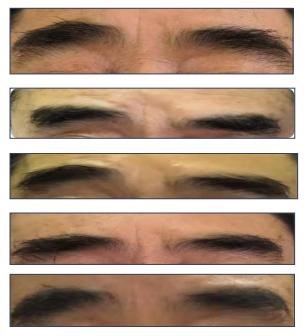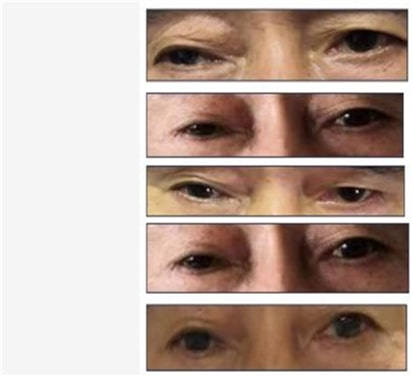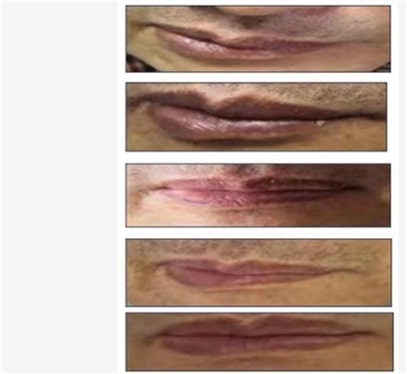Clinical & Medical Surgery
Open Access
Volume 1
Qiang Wu; Guangming Wang; Hongfei Wang*
*Corresponding Author: Hongfei Wang
Jiangning Hospital of TCM, Nanjing, China.
Email: 361663919@qq.com
Article Info
Received: Nov 25, 2022
Accepted: Jan 12, 2023
Published: Jan 19, 2023
Archived: www.jclinmedsurgery.com
Copyright: © Wang H (2023).
Citation: Wu Q, Wang G, Wang H. Acupoint Injection of Obstinate Facial Paralysis: A Case Report. J Clin Med Surgery. 2023; 3(1): 1066.
Facial paralysis is a common condition and add its manifestations are Muscle paralysis, Angle of mouth askew, frontal stria disappearance and difficulty in eye closing on the affected side of the face [1,2]. According to the injury site, facial paralysis is divided into peripheral type and central type. Facial paralysis can be caused by viral or bacterial infections, benign or malignant tumors of the head or neck and traumatic facial paralysis [3]. Conventional treatments are medicine, massage, physiotherapy and acupuncture [4]. Intractable facial paralysis is delayed and wrongly treated for more than three months without significant improvement in symptoms. The prognosis of each condition varies greatly [5]. On the basis of comprehensive treatment drugs are injected into acupuncture points. The treatment could last for three months with satisfactory results.
We report the case of a 63-year-old man with left-sided facial paralysis who was treated during his hospitalization. Six months ago, his right side of the face was paralyzed, and the symptoms disappeared after the treatment in the People’s Hospital. But three months ago, he developed facial paralysis on left side while his brain Magnetic Resonance (MRI) and Electromyography (EMG) were normal. He received intravenous infusion medication for one week, acupuncture treatment for three weeks in the people’s hospital, but the treatment was ineffective. Then he came to the Rehabilitation Medicine Department of Jiangning Hospital of Traditional Chinese Medicine. He felt anxious, disappointed and helpless. His left muscle was paralyzed, the corners of his mouth were crooked, his forehead lines disappeared, and he could not close his eyes on the affected side.
His tongue was pale with a white coating. His pulse was thin. Acupuncture was performed on ST2, ST4, ST6, ST36 of the stomach meridian of Foot Yangming, BL1 and BL2 of the bladder meridian of Foot Taiyang, and SJ23 of the Sanjiao meridian of Hand Shaoyang respectively. These traditional acupoints were selected based on published clinical case reports and systematic reviews of acupuncture in patients with ophthalmic diseases [6,7]. All acupoints were injected with physiological salt solution (0.9% NaCl). Acupuncture was performed twice a week for 8 weeks.
After 8 sessions, the patient’s upper eyelid levator muscle activity improved, the upper eyelid was normal, and no further fatigue and dizziness. The before and after photos are shown in Figure 1, Figure 2, Figure 3, and Figure 4, respectively.
We found that acupoint injection improved the long-term sequelae of facial paralysis. This case report provides strong support for the use of acupoint injection in cases of subacute and chronic paralysis for which other treatment modalities have failed. Acupoint injection is a quick, non-invasive and painless method that is easy for physicians to operate and easy for patients to accept. These features, combined with the safety of acupoint injection, make it a promising adjunctive therapy for chronic facial paralysis. Significant improvement in this condition requires large prospective studies to confirm our findings.
Declaration
Conflicting of interest: The author declared no potential conflicts of interest with respect to the research, authorship, and/ or publication of this article.
Ethical approval: Our institution does not require ethical approval for reporting individual cases or case series.
Support: This published case report was supported by Jiangning Hospital of TCM.
Informed consent: Written informed consent was obtained from the patient for their anonymized information to be published in this article.
References
- Weaver DT. Current management of child-hood ptosis. Curr Opin Ophthalmol. 2018; 29: 395-400.
- de Almeida JR, Guyatt GH, Sud S, Dorion J, Hill MD, et al. Management of Bell palsy: clinical practice guideline. CMAJ. 2014; 186: 917-922.
- Gil Ton, Lee LW, Chen YH, Tu CH, Lee YC, et al. Effffects of laser acupuncture in a patient with a 12-year history of facial paralysis: A case report. Complementary Therapies in Medicine. 2019; 43: 306-310.
- Gordin E, Lee TS, Ducic Y, Arnaoutakis D. Facial nerve trauma: Evaluation and considerations in management. Craniomaxillofac Trauma Reconstr. 2015; 8: 1-13.
- Peitersen E. Bell’s palsy: The spontaneous course of 2,500 peripheral facial nerve palsies of difffferent etiologies. Acta Otolaryngol Suppl. 2002; 549: 4-30.
- Zhi F, Huang Q, Zhao Y, Yang Y, Zhang J, et al. The patterns analysis of clinical application of acupuncture for ophthalmopathy. Zhongguo Zhen Jiu. 2018; 38: 907–912.
- Yun Jin Kim. Acupuncture management of blepharoptosis: a case report. Acupunct Med. 2019; 38: 201-202.



